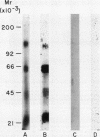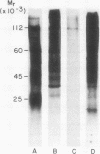Abstract
The objectives of this study were to identify filarial antigens which induce enhanced clearance of circulating microfilariae and to establish if human antibody reactivity with these molecules correlates with the apparent parasite burdens of residents of an endemic area of Bancroftian filariasis. Mice immunized with an extract of Brugia malayi microfilariae develop IgG antibodies to four major filarial antigens with an apparent molecular weight (Mr) of approximately 112,000, 60,000, 45,000, and 25,000. Animals immunized with gel slices containing the approximately 25,000-Mr antigen are resistant to intravenous challenge with live microfilariae (78-98% reduction in parasitemia vs. controls, P less than 0.01). A group of 22 amicrofilaremic humans had a significantly higher (P less than 0.025) mean antibody titer to the Mr 25,000-Mr antigen (1: 424) than 16 microfilaremic individuals (1:95). There were no significant differences between the two groups in antibody titers to filarial antigens of Mr approximately 112,000, 60,000, and 45,000 Mr. These data suggest that a high degree of reactivity to the 25,000-Mr antigen in humans with lymphatic filariasis correlates with a parasitologic status that is least conducive to transmission of infection.
Full text
PDF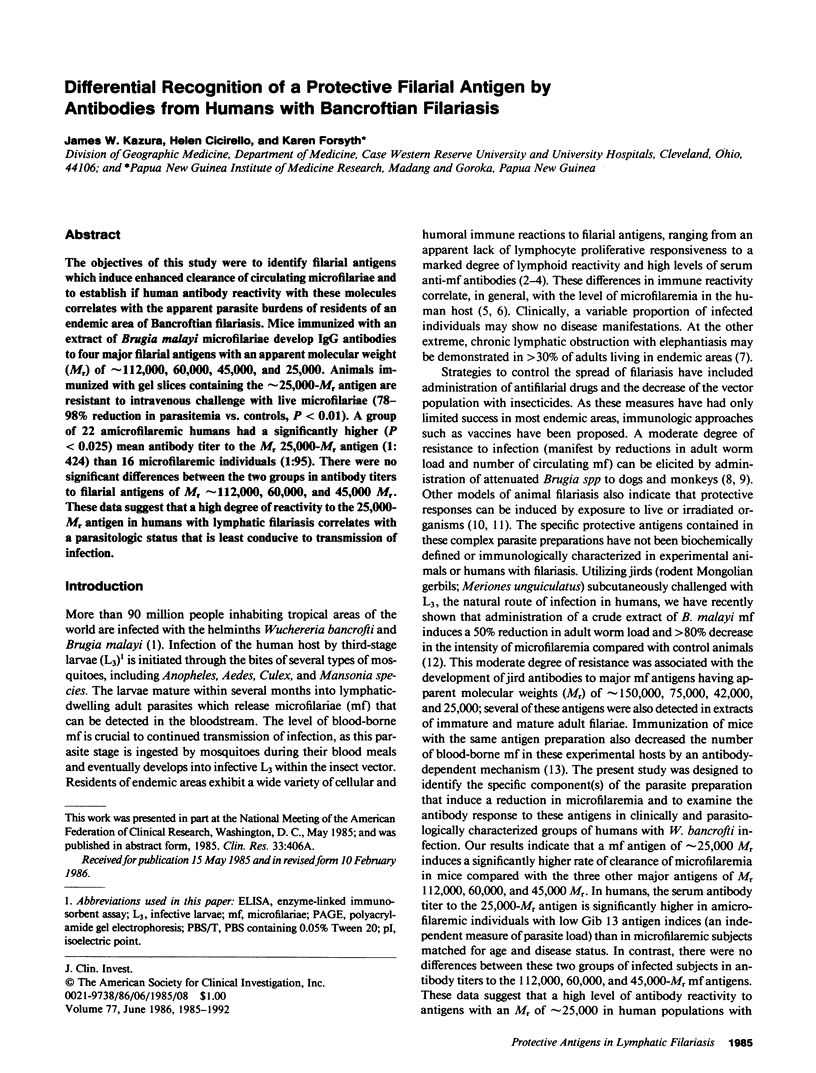
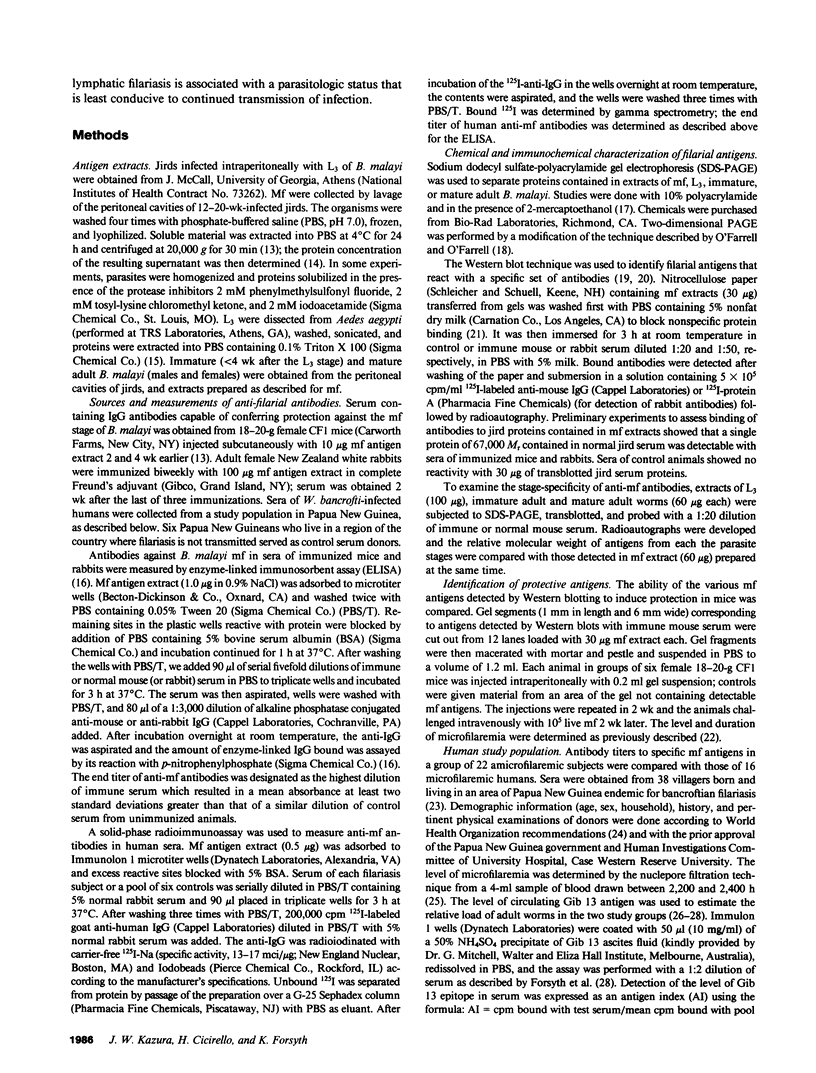
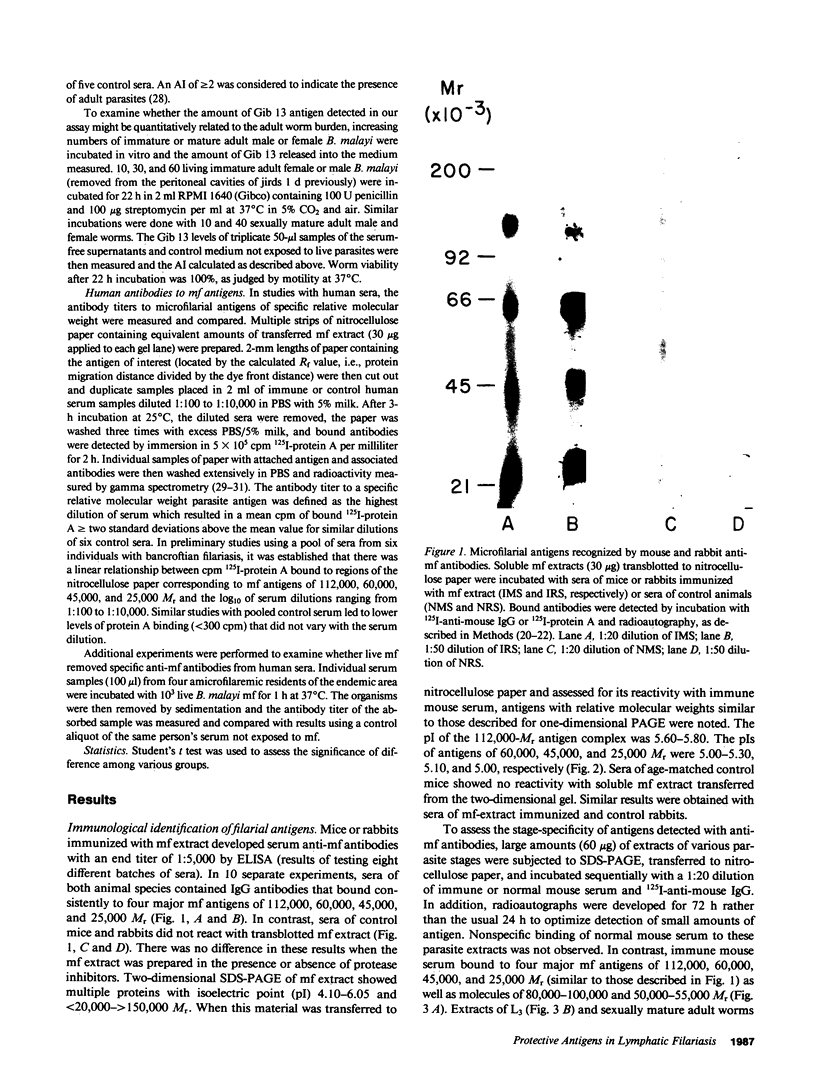
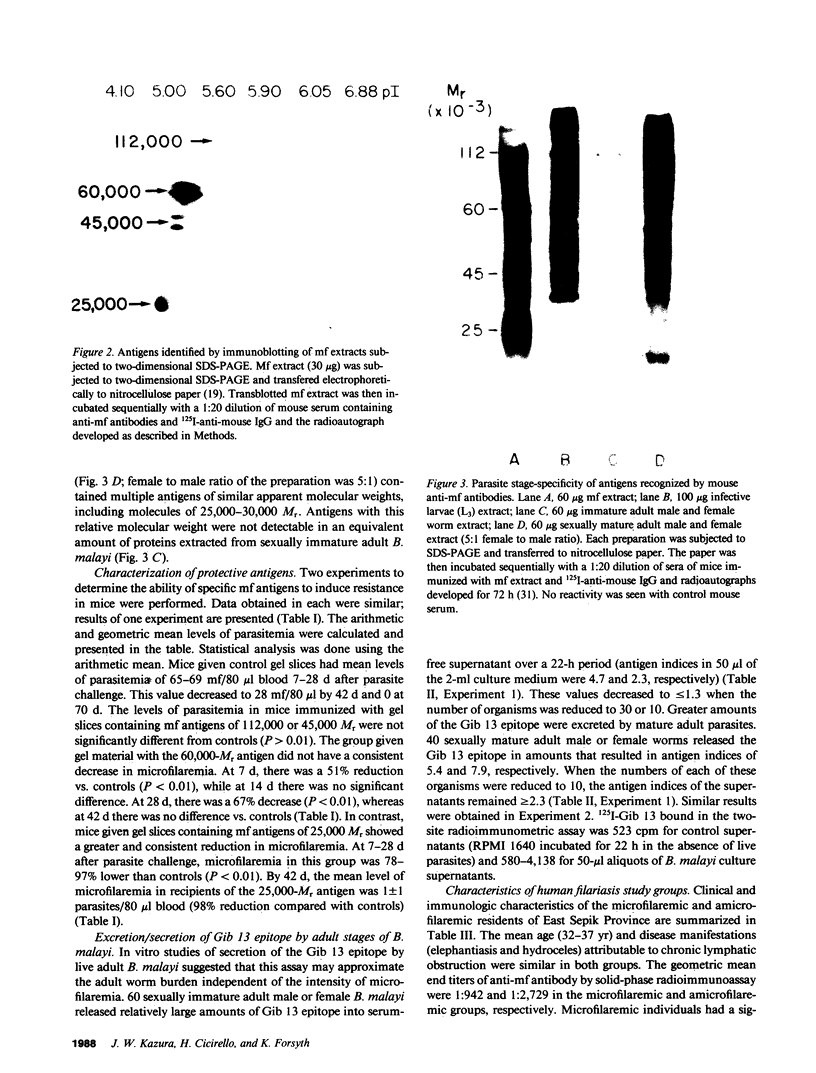
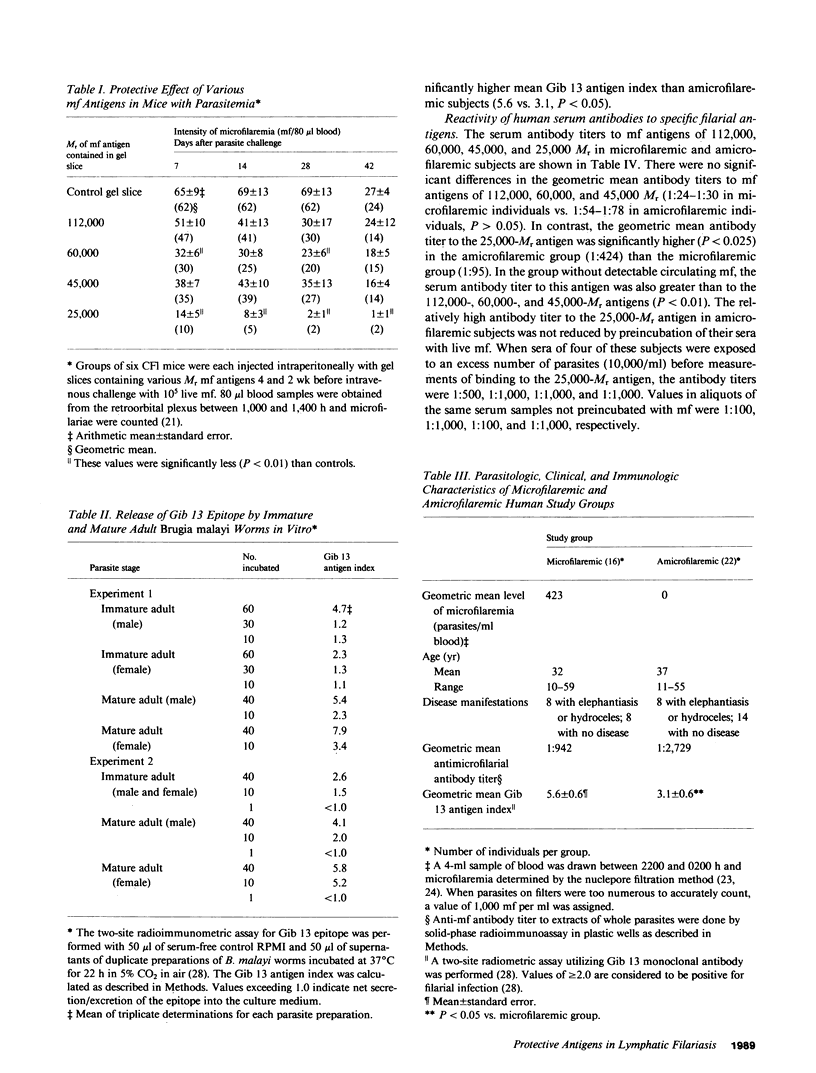
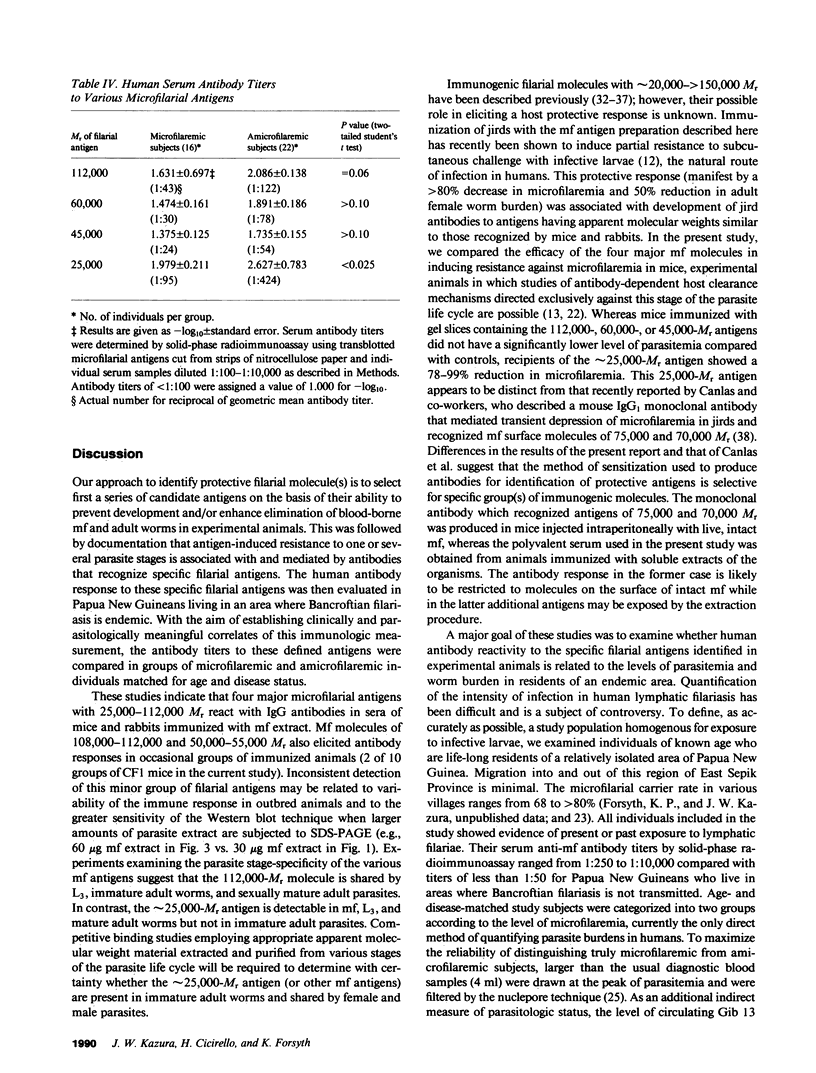
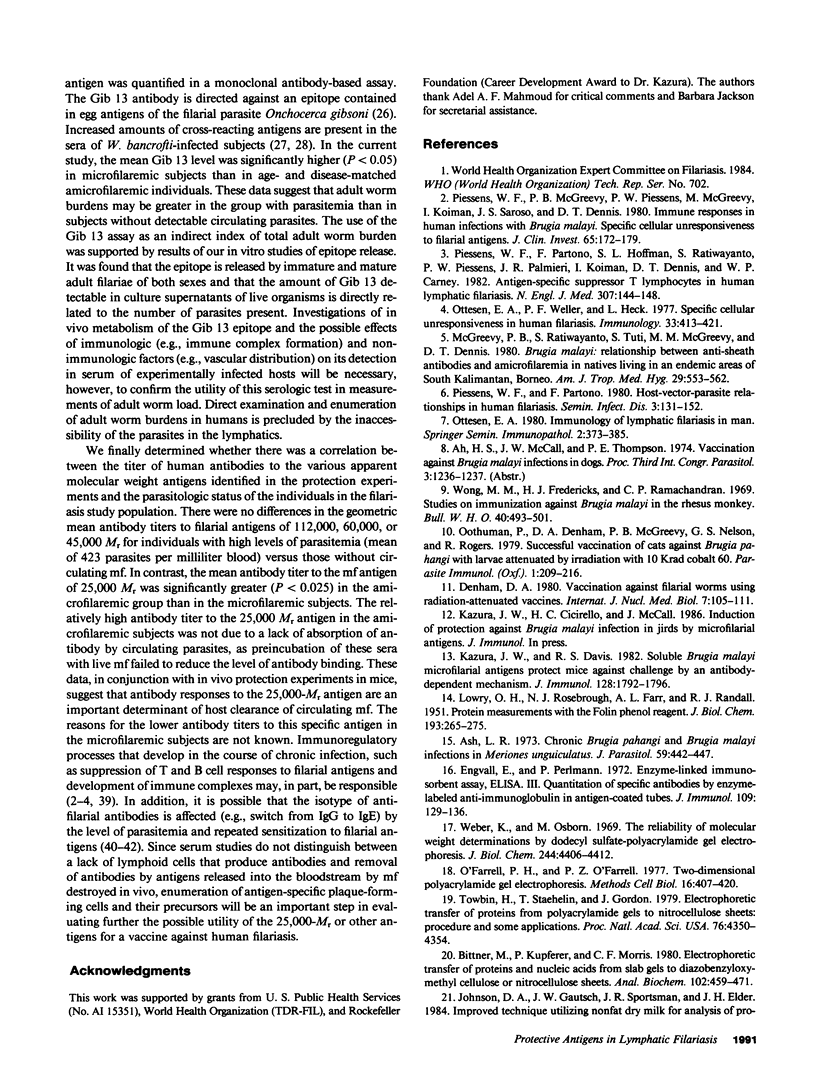
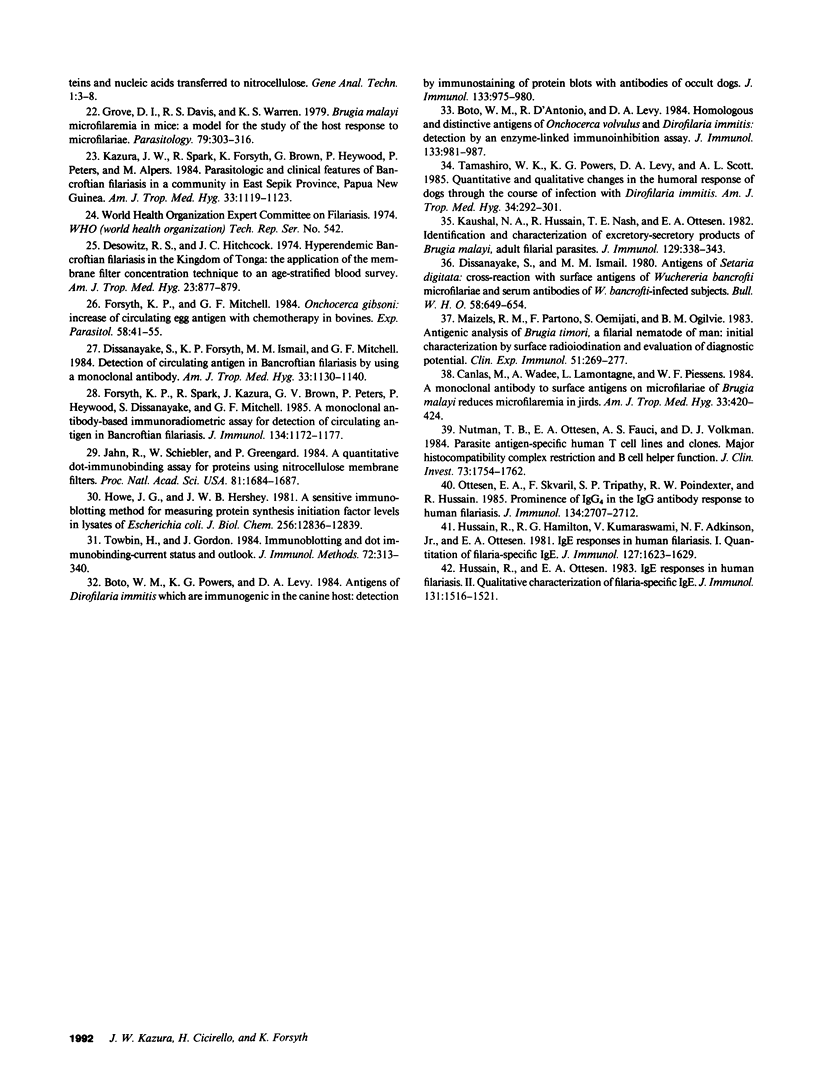
Images in this article
Selected References
These references are in PubMed. This may not be the complete list of references from this article.
- Ash L. R. Chronic Brugia pahangi and Brugia malayi infections in Meriones unguiculatus. J Parasitol. 1973 Jun;59(3):442–447. [PubMed] [Google Scholar]
- Bittner M., Kupferer P., Morris C. F. Electrophoretic transfer of proteins and nucleic acids from slab gels to diazobenzyloxymethyl cellulose or nitrocellulose sheets. Anal Biochem. 1980 Mar 1;102(2):459–471. doi: 10.1016/0003-2697(80)90182-7. [DOI] [PubMed] [Google Scholar]
- Boto W. M., D'Antonio R., Levy D. A. Homologous and distinctive antigens of Onchocerca volvulus and Dirofilaria immitis: detection by an enzyme-linked immuno-inhibition assay. J Immunol. 1984 Aug;133(2):981–987. [PubMed] [Google Scholar]
- Boto W. M., Powers K. G., Levy D. A. Antigens of Dirofilaria immitis which are immunogenic in the canine host: detection by immuno-staining of protein blots with the antibodies of occult dogs. J Immunol. 1984 Aug;133(2):975–980. [PubMed] [Google Scholar]
- Canlas M., Wadee A., Lamontagne L., Piessens W. F. A monoclonal antibody to surface antigens on microfilariae of Brugia malayi reduces microfilaremia in infected jirds. Am J Trop Med Hyg. 1984 May;33(3):420–424. doi: 10.4269/ajtmh.1984.33.420. [DOI] [PubMed] [Google Scholar]
- Denham D. A. Vaccination against filarial worms using radiation-attenuated vaccines. Int J Nucl Med Biol. 1980;7(2):105–111. doi: 10.1016/0047-0740(80)90028-5. [DOI] [PubMed] [Google Scholar]
- Desowitz R. S., Hitchcock J. C. Hyperendemic bancroftian filariasis in the Kingdom of Tonga: the application of the membrane filter concentration technique to an age-stratified blood survey. Am J Trop Med Hyg. 1974 Sep;23(5):877–879. doi: 10.4269/ajtmh.1974.23.877. [DOI] [PubMed] [Google Scholar]
- Dissanayake S., Forsyth K. P., Ismail M. M., Mitchell G. F. Detection of circulating antigen in bancroftian filariasis by using a monoclonal antibody. Am J Trop Med Hyg. 1984 Nov;33(6):1130–1140. doi: 10.4269/ajtmh.1984.33.1130. [DOI] [PubMed] [Google Scholar]
- Dissanayake S., Ismail M. M. Antigen of Setaria digitata: cross-reaction with surface antigens of Wuchereria bancrofti microfilariae and serum antibodies of W. bancrofti-infected subjects. Bull World Health Organ. 1980;58(4):649–654. [PMC free article] [PubMed] [Google Scholar]
- Engvall E., Perlmann P. Enzyme-linked immunosorbent assay, Elisa. 3. Quantitation of specific antibodies by enzyme-labeled anti-immunoglobulin in antigen-coated tubes. J Immunol. 1972 Jul;109(1):129–135. [PubMed] [Google Scholar]
- Forsyth K. P., Mitchell G. F., Copeman D. B. Onchocerca gibsoni: increase of circulating egg antigen with chemotherapy in bovines. Exp Parasitol. 1984 Aug;58(1):41–55. doi: 10.1016/0014-4894(84)90019-5. [DOI] [PubMed] [Google Scholar]
- Forsyth K. P., Spark R., Kazura J., Brown G. V., Peters P., Heywood P., Dissanayake S., Mitchell G. F. A monoclonal antibody-based immunoradiometric assay for detection of circulating antigen in Bancroftian filariasis. J Immunol. 1985 Feb;134(2):1172–1177. [PubMed] [Google Scholar]
- Grove D. I., Davis R. S., Warren K. S. Brugia malayi microfilaraemia in mice: a model for the study of the host response to microfilariae. Parasitology. 1979 Dec;79(3):303–316. doi: 10.1017/s0031182000053713. [DOI] [PubMed] [Google Scholar]
- Howe J. G., Hershey J. W. A sensitive immunoblotting method for measuring protein synthesis initiation factor levels in lysates of Escherichia coli. J Biol Chem. 1981 Dec 25;256(24):12836–12839. [PubMed] [Google Scholar]
- Hussain R., Hamilton R. G., Kumaraswami V., Adkinson N. F., Jr, Ottesen E. A. IgE responses in human filariasis. I. Quantitation of filaria-specific IgE. J Immunol. 1981 Oct;127(4):1623–1629. [PubMed] [Google Scholar]
- Hussain R., Ottesen E. A. IgE responses in human filariasis. II. Qualitative characterization of filaria-specific IgE. J Immunol. 1983 Sep;131(3):1516–1521. [PubMed] [Google Scholar]
- Jahn R., Schiebler W., Greengard P. A quantitative dot-immunobinding assay for proteins using nitrocellulose membrane filters. Proc Natl Acad Sci U S A. 1984 Mar;81(6):1684–1687. doi: 10.1073/pnas.81.6.1684. [DOI] [PMC free article] [PubMed] [Google Scholar]
- Kaushal N. A., Hussain R., Nash T. E., Ottesen E. A. Identification and characterization of excretory-secretory products of Brugia malayi, adult filarial parasites. J Immunol. 1982 Jul;129(1):338–343. [PubMed] [Google Scholar]
- Kazura J. W., Davis R. S. Soluble Brugia malayi microfilarial antigens protect mice against challenge by an antibody-dependent mechanism. J Immunol. 1982 Apr;128(4):1792–1796. [PubMed] [Google Scholar]
- Kazura J. W., Spark R., Forsyth K., Brown G., Heywood P., Peters P., Alpers M. Parasitologic and clinical features of bancroftian filariasis in a community in East Sepik Province, Papua New Guinea. Am J Trop Med Hyg. 1984 Nov;33(6):1119–1123. doi: 10.4269/ajtmh.1984.33.1119. [DOI] [PubMed] [Google Scholar]
- LOWRY O. H., ROSEBROUGH N. J., FARR A. L., RANDALL R. J. Protein measurement with the Folin phenol reagent. J Biol Chem. 1951 Nov;193(1):265–275. [PubMed] [Google Scholar]
- Maizels R. M., Partono F., Oemijati S., Ogilvie B. M. Antigenic analysis of Brugia timori, a filarial nematode of man: initial characterization by surface radioiodination and evaluation of diagnostic potential. Clin Exp Immunol. 1983 Feb;51(2):269–277. [PMC free article] [PubMed] [Google Scholar]
- McGreevy P. B., Ratiwayanto S., Tuti S., McGreevy M. M., Dennis D. T. Brugia malayi: relationship between anti-sheath antibodies and amicrofilaremia in natives living in an endemic area of South Kalimantan, Borneo. Am J Trop Med Hyg. 1980 Jul;29(4):553–562. doi: 10.4269/ajtmh.1980.29.553. [DOI] [PubMed] [Google Scholar]
- Nutman T. B., Ottesen E. A., Fauci A. S., Volkman D. J. Parasite antigen-specific human T cell lines and clones. Major histocompatibility complex restriction and B cell helper function. J Clin Invest. 1984 Jun;73(6):1754–1762. doi: 10.1172/JCI111384. [DOI] [PMC free article] [PubMed] [Google Scholar]
- O'Farrell P. H., O'Farrell P. Z. Two-dimensional polyacrylamide gel electrophoretic fractionation. Methods Cell Biol. 1977;16:407–420. doi: 10.1016/s0091-679x(08)60116-8. [DOI] [PubMed] [Google Scholar]
- Oothuman P., Denham D. A., McGreevy P. B., Nelson G. S., Rogers R. Successful vaccination of cats against Brugia pahangi with larvae attenuated by irradiation with 10 krad cobalt 60. Parasite Immunol. 1979 Autumn;1(3):209–216. doi: 10.1111/j.1365-3024.1979.tb00707.x. [DOI] [PubMed] [Google Scholar]
- Ottesen E. A., Skvaril F., Tripathy S. P., Poindexter R. W., Hussain R. Prominence of IgG4 in the IgG antibody response to human filariasis. J Immunol. 1985 Apr;134(4):2707–2712. [PubMed] [Google Scholar]
- Ottesen E. A., Weller P. F., Heck L. Specific cellular immune unresponsiveness in human filariasis. Immunology. 1977 Sep;33(3):413–421. [PMC free article] [PubMed] [Google Scholar]
- Piessens W. F., McGreevy P. B., Piessens P. W., McGreevy M., Koiman I., Saroso J. S., Dennis D. T. Immune responses in human infections with Brugia malayi: specific cellular unresponsiveness to filarial antigens. J Clin Invest. 1980 Jan;65(1):172–179. doi: 10.1172/JCI109648. [DOI] [PMC free article] [PubMed] [Google Scholar]
- Piessens W. F., Partono F., Hoffman S. L., Ratiwayanto S., Piessens P. W., Palmieri J. R., Koiman I., Dennis D. T., Carney W. P. Antigen-specific suppressor T lymphocytes in human lymphatic filariasis. N Engl J Med. 1982 Jul 15;307(3):144–148. doi: 10.1056/NEJM198207153070302. [DOI] [PubMed] [Google Scholar]
- Tamashiro W. K., Powers K. G., Levy D. A., Scott A. L. Quantitative and qualitative changes in the humoral response of dogs through the course of infection with Dirofilaria immitis. Am J Trop Med Hyg. 1985 Mar;34(2):292–301. doi: 10.4269/ajtmh.1985.34.292. [DOI] [PubMed] [Google Scholar]
- Towbin H., Gordon J. Immunoblotting and dot immunobinding--current status and outlook. J Immunol Methods. 1984 Sep 4;72(2):313–340. doi: 10.1016/0022-1759(84)90001-2. [DOI] [PubMed] [Google Scholar]
- Towbin H., Staehelin T., Gordon J. Electrophoretic transfer of proteins from polyacrylamide gels to nitrocellulose sheets: procedure and some applications. Proc Natl Acad Sci U S A. 1979 Sep;76(9):4350–4354. doi: 10.1073/pnas.76.9.4350. [DOI] [PMC free article] [PubMed] [Google Scholar]
- Weber K., Osborn M. The reliability of molecular weight determinations by dodecyl sulfate-polyacrylamide gel electrophoresis. J Biol Chem. 1969 Aug 25;244(16):4406–4412. [PubMed] [Google Scholar]
- Wong M. M., Fredericks H. J., Ramachandran C. P. Studies on immunization against Brugia malayi infection in the rhesus monkey. Bull World Health Organ. 1969 Apr;40(4):493–501. [PMC free article] [PubMed] [Google Scholar]



